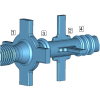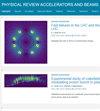Fabrication and testing of the transition section between modules of a wakefield accelerator
IF 1.8
3区 物理与天体物理
Q3 PHYSICS, NUCLEAR
Physical Review Accelerators and Beams
Pub Date : 2024-08-14
DOI:10.1103/physrevaccelbeams.27.081303
引用次数: 0
Abstract
The fabrication process is presented for a typical transition section located between each cylindrical corrugated waveguide structure comprising the wakefield accelerator module. The transition section includes couplers for extracting the 180 GHz accelerating mode and separate couplers for extracting the 190 GHz dipole mode, both modes induced by the electron bunch traversing the cylindrical corrugated waveguide structure. Extraction of the high-power accelerating mode reduces the heat load due to the subterahertz wave power dissipation within the corrugated accelerating structure. Extraction of the low-power dipole mode serves the purpose of detecting the electron bunch transverse oscillations within the wakefield accelerator and identifying the onset of beam breakup instability. Comprehensive testing of the fully functional transition section with an electron beam was done at the Accelerator Test Facility in Brookhaven National Laboratory which verified the functionality of the transition section.

制造和测试汪场加速器模块之间的过渡段
本文介绍了位于构成汪场加速器模块的每个圆柱波纹波导结构之间的典型过渡段的制造工艺。过渡段包括用于提取 180 GHz TM01 加速模式的耦合器和用于提取 190 GHz HE11 偶极子模式的独立耦合器,这两种模式都是由穿越圆柱波纹波导结构的电子束诱导产生的。提取高功率加速模式可降低波纹加速结构内亚赫兹波功率耗散所产生的热负荷。提取低功率偶极子模式的目的是检测唤醒场加速器内的电子束横向振荡,并确定束破裂不稳定性的开始。在布鲁克海文国家实验室的加速器测试设备上用电子束对全功能过渡段进行了全面测试,验证了过渡段的功能。
本文章由计算机程序翻译,如有差异,请以英文原文为准。
求助全文
约1分钟内获得全文
求助全文
来源期刊

Physical Review Accelerators and Beams
Physics and Astronomy-Surfaces and Interfaces
CiteScore
3.90
自引率
23.50%
发文量
158
审稿时长
23 weeks
期刊介绍:
Physical Review Special Topics - Accelerators and Beams (PRST-AB) is a peer-reviewed, purely electronic journal, distributed without charge to readers and funded by sponsors from national and international laboratories and other partners. The articles are published by the American Physical Society under the terms of the Creative Commons Attribution 3.0 License.
It covers the full range of accelerator science and technology; subsystem and component technologies; beam dynamics; accelerator applications; and design, operation, and improvement of accelerators used in science and industry. This includes accelerators for high-energy and nuclear physics, synchrotron-radiation production, spallation neutron sources, medical therapy, and intense-beam applications.
 求助内容:
求助内容: 应助结果提醒方式:
应助结果提醒方式:


